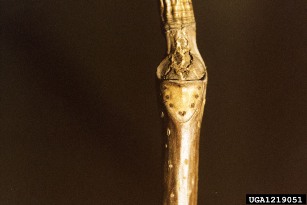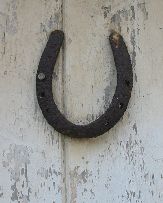Interactions
HUMANS
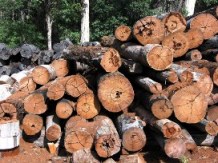
Lumber - Though not a prevalent wood used in the United States, the horse chestnut tree is a more common used source of lumber in Europe. It is used predominately for veneer, furniture and plywood. The creamy yellowish brown color of the wood, the ease of working with and finishing it all contribute to this use.
However, the wood is non-durable, the grains are not straight,
and the resulting lumber is not particularly strong.
 Ornamental landscaping
- Aesculus
Hippocastanum trees are incredibly aesthetically pleasant. They have large white flowers that are accented with yellow and red centers. The tree itself is impressively sized and can become very full. These characteristics allowed the Horse Chestnut to spread throughout the Northern Hemisphere. People began to cultivate these trees to be placed
throughout their communities and homes. They are very often found in parks, gardens, estates, residential areas, golf courses, and on campuses. For more on their distribution, see Habitat.
Ornamental landscaping
- Aesculus
Hippocastanum trees are incredibly aesthetically pleasant. They have large white flowers that are accented with yellow and red centers. The tree itself is impressively sized and can become very full. These characteristics allowed the Horse Chestnut to spread throughout the Northern Hemisphere. People began to cultivate these trees to be placed
throughout their communities and homes. They are very often found in parks, gardens, estates, residential areas, golf courses, and on campuses. For more on their distribution, see Habitat.
Entertainment - In the Village Green at Ashton in
Northamptonshire on the second Sunday in October, the World
Conker Championships are held. Conker is
another name for the seeds of a horse chestnut tree,
specifically when used to play the game "Conkers/Kingers."
In the fall, fruit of the horse chestnut will ripen, the outer
spiny casing will reveal the contained conkers, and the fruit
will fall from the tree. People then select the uncracked,
hard, and symmetrical seeds and drill a hole in the middle to
attach to a 25 cm (approx. 10 in) long string. Also while
selecting for the best conkers, people will test to see if they
float. If they do it means that they probably have
sustained damage inside to account for the lack of density.
One participant wraps part of the string around their hands and
pull it back to strike the other's seed. The opponent has
to hold the conker completely still for the strike. The
players alternate strikes until one of the conkers is completely
destroyed. At this point this game seems rather simple,
but that is completely decieving! If a player misses while
attempting a strike, the opponent obtains two extra strikes.
If a string is tangled and the opponent calls "strings" they
receive an extra strike. If a conker is striked and
completes a full circle, the player who just delivered that
strike gets an additional strike. Lastly, if a conker is
dropped and the other player yells "stamps" they are allowed to
jump on it, but if the player who dropped it yells "no stamps
first" they can simply pick it back up! On top of this,
not only does this game have a complex scoring system, it also
has a complex ranking system to keep track of the achievements
and victories a "conker" has accomplished.
Health - see
Health
& Horse Chestnuts.
PARASITES/PATHOGENS
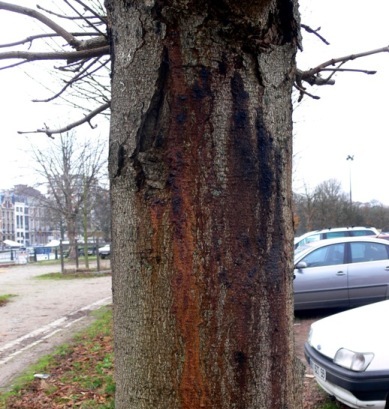
Pseudomonas syringae pv. aesculi -
The
Pseudomonas syringae pv. aesculi is a
Gram-negative rod-shaped bacteria which is a very significant
pathogen to Horse Chestnut trees. Though this pathogen has
apparently not reached the United States, it is present in a
great percentage of European trees. In 2007 it was found that
around 49%of Horse Chestnut trees in the United Kingdom were
infected by P. syringae and about 30% were infected in
the Netherlands. Early on in the infection trees will
display red, yellow or black bleeding lesions located at the
base of the tree. As the infection progresses the lesions
expand upwards. Trees can also start to display leaf
discoloration, early leaf drop, cracked or missing bark, and
eventually even girdling. This bacterium has been shown to
invade the trunks, branches, leaves, flowers and fruits.
However, it seems unable to be transmitted through the seeds.
 The Animal and Plant Health Inspection Service (APHIS) issued
a federal order effective beginning on January 25, 2010 that
stopped importation of any trees for planting of the
Aesculus genus from any country, except Canada. These
extreme measures had to be taken as plant pathogens like P.
syringae are very hard to find in simple inspections at
time of importation. Even if an infection is recognized,
the infection of Horse Chestnut by P. syringae has been
often misdiagnosed as infection by Phytophthora sp.
See Phytophtora sp. lower on this
page.
The Animal and Plant Health Inspection Service (APHIS) issued
a federal order effective beginning on January 25, 2010 that
stopped importation of any trees for planting of the
Aesculus genus from any country, except Canada. These
extreme measures had to be taken as plant pathogens like P.
syringae are very hard to find in simple inspections at
time of importation. Even if an infection is recognized,
the infection of Horse Chestnut by P. syringae has been
often misdiagnosed as infection by Phytophthora sp.
See Phytophtora sp. lower on this
page.
Cameraria ohridella(Horse Chestnut Leaf
Miner) -
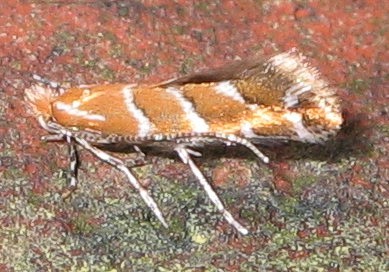 The Horse Chestnut Leaf Miner appeared to
human knowledge for the first time in 1984 in Macedonia and has
since spread all over Europe. It takes very little
time,
respectively for these insects to establish in significant
numbers as they can generate about 3 complete generations in a
single year. The C. ohridella also has a very small
number of effective natural predators/threats. This
assists them in their rapid spread and increase in population.
As can be logically reasoned from this species of insect's name,
Aesculus Hippocastanum are very important hosts for
their survival. The larval form will mine through and feed
on the trees. This results in early leaf drop and a second
flowering with fewer seeds.
The Horse Chestnut Leaf Miner appeared to
human knowledge for the first time in 1984 in Macedonia and has
since spread all over Europe. It takes very little
time,
respectively for these insects to establish in significant
numbers as they can generate about 3 complete generations in a
single year. The C. ohridella also has a very small
number of effective natural predators/threats. This
assists them in their rapid spread and increase in population.
As can be logically reasoned from this species of insect's name,
Aesculus Hippocastanum are very important hosts for
their survival. The larval form will mine through and feed
on the trees. This results in early leaf drop and a second
flowering with fewer seeds.
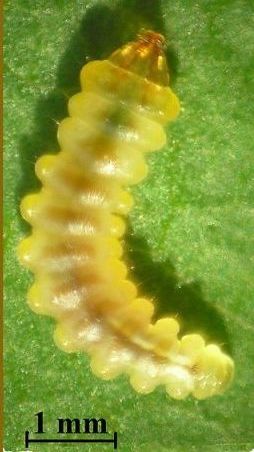 Though this infestation has
not been seen to lead to any significant die-off of the trees,
much time and resources have been put towards finding an
efficient method to controlling this invasive pest. In
2010 a paper titled "An attempt to control Cameraria
ohridella using an attract-and-kill technique" was
published summarizing previously tested methods and the results
of an attract-and-kill method. The paper first describes
the most effective methods in place currently, which are the
removal of leaf litter and spread of chemical insecticides on
the leaves of the trees. The developed "attract-and-kill"
method consisted of attracting the male moths with sex
pheromones and then killing them with a fast acting contact
toxicant. However, hopes for finding a more effective
method were smashed when it was concluded that their specified
method failed to prove effective. The researchers utilized
trap catches to quantify the insect population and even though
these traps indicated that the populations in the treated areas
were decreased, the damage to the horse chestnut leaves were not
significantly different in treated vs. non-treated areas.
This was contributed to the mobility of the insects to migrate
over large areas and the small size of the treated areas.
Though this infestation has
not been seen to lead to any significant die-off of the trees,
much time and resources have been put towards finding an
efficient method to controlling this invasive pest. In
2010 a paper titled "An attempt to control Cameraria
ohridella using an attract-and-kill technique" was
published summarizing previously tested methods and the results
of an attract-and-kill method. The paper first describes
the most effective methods in place currently, which are the
removal of leaf litter and spread of chemical insecticides on
the leaves of the trees. The developed "attract-and-kill"
method consisted of attracting the male moths with sex
pheromones and then killing them with a fast acting contact
toxicant. However, hopes for finding a more effective
method were smashed when it was concluded that their specified
method failed to prove effective. The researchers utilized
trap catches to quantify the insect population and even though
these traps indicated that the populations in the treated areas
were decreased, the damage to the horse chestnut leaves were not
significantly different in treated vs. non-treated areas.
This was contributed to the mobility of the insects to migrate
over large areas and the small size of the treated areas.
Other pathogens/parasites -
Powdery mildew is a term used for many different species of
fungi that parasitize plants causing the appearance of a fuzzy
white layer on the epidermis of leaves. In particular, the
fungus Uncinula (Erysiphe) flexuosa is particularly
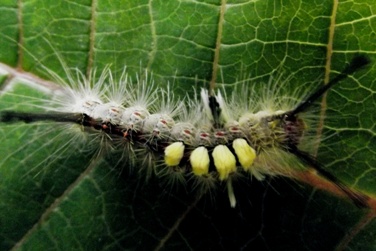 known to act as a parasite on horse chestnut trees. This ascomycota does not only attach to horse chestnuts as its range
spreads from North America to Russia! To read about another
organism with this same pathogen take a look at
Salvia oficinales.
known to act as a parasite on horse chestnut trees. This ascomycota does not only attach to horse chestnuts as its range
spreads from North America to Russia! To read about another
organism with this same pathogen take a look at
Salvia oficinales.
The caterpillars of the whitemarked tussock moth commonly
feed on the leaves of the horse chestnut tree. These
caterpillars use their mouth parts to either skeletonize the
leaves or consume all of the leaf except for the major veins.
This depends on the age of the caterpillars. However, they
do not pose much of a serious threat to horse chestnut trees as
a whole.
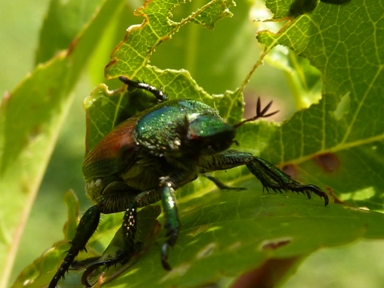 The Japanese beetle can cause two different major groups of
symptoms in horse chestnut trees. As adults these beetles
will cause holes in the leaves and as grubs they will cause discolorated and unhealthy patches. In the adult stage
these organisms display a metallic green color with
bronze-colored wings.
The Japanese beetle can cause two different major groups of
symptoms in horse chestnut trees. As adults these beetles
will cause holes in the leaves and as grubs they will cause discolorated and unhealthy patches. In the adult stage
these organisms display a metallic green color with
bronze-colored wings.
The bagworm, the larval stage of the moth
Thyridopteryx ephemeraeformis, can feed on a huge variety
of deciduous and evergreen trees. These organism cleverly
disguise themselves with leaves and twigs from the tree and
therefore often avoid identification.
The Asian longhorned beetle, Anoplophora glabripennis,
is thought to have traveled from Asia to the United States
in the 1990s on wood materials being transported. This
arthropod is identified by the white markings on its black body
and antennae. The host trees are used as a location for
the eggs to be laid and hatched. Once in larval form,
these organisms feed on the vascular layer beneath the bark of
the tree.


ENVIRONMENTAL IMPACT-
One reason Aesculus hippocastanum are so
desirable to have in an environment is the large impact they can
have on local biodiversity and environmental health. To
start, because of the photosynthesis the horse chestnut
undergoes, it contributes to the absorption of carbon dioxide
and the production of oxygen. In some locations the trees
also allow for less use of energy consuming air conditioners by
providing shade for surrounding buildings. The roots can
function to filter rain water, improving the quality of local
water, and stabilize the surrounding soil.
For basic survival, all organisms need shelter, food and
water. The horse chestnut can provide these either
directly or indirectly to organisms to support biodiversity and
life. A huge variety of birds and small animals use these
trees for shelter. In aquatic environments they are also
able to provide shelter and/or habitat to the organisms.
Directly, the horse chestnut tree is used as a food source for
many parasites including the previously discussed caterpillars,
fungus, beetles, etc. The seeds are often eaten by deer and
grazing animals. However, eating this plant is not risk
free for these animals. See
Health & Horse Chestnuts for
more on the poisonous effects of the horse chestnut. As
far as providing water, horse chestnuts have the ability to
alter the temperature of water through shade and filter rain
water through its roots.
OTHER-
Allelopathic nature-
The horse chestnut releases chemicals through the roots
of the tree that can inhibit surrounding plant growth.
This gives the trees a competitive advantage for space and other
resources. The term allelopathy comes from allelon meaning
"of each other" and pathos meaning "to suffer."
To explore more about Allelopathic chemicals and behaviors visit
Allelopathic nature.
Rat poison- All parts of the horse chestnut
contain the toxin aesculin. Even though the rat poison
warfarin is directly created from clovers containing a similar
toxin, aesculin from horse chestnuts was used to develop the
poison. For more on the effects of aesculin see Horse &
Horse Chestnuts.
If you would like to read about a different organisms that
"loves parasitic relationships," visit
Xanthomonas campestris.
